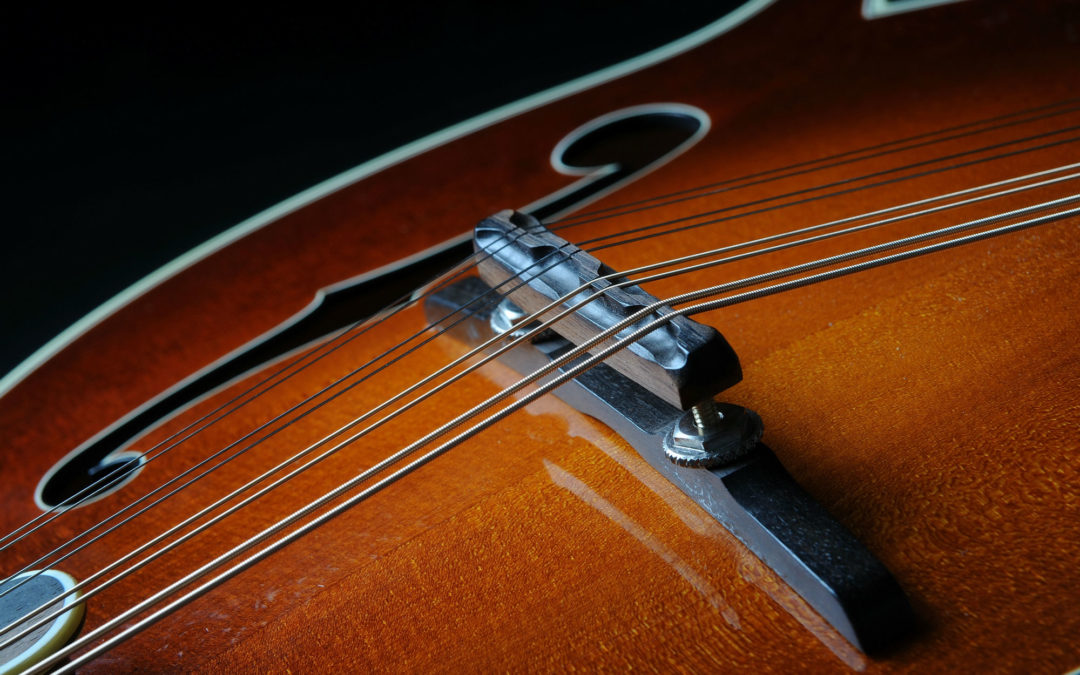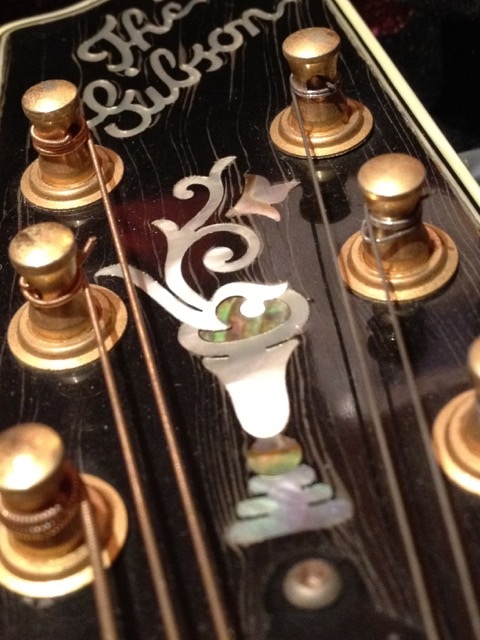
Customization, Mandolin Repair, Necks, Speed Necks
By Brian Beker
One score and seven years ago, I sold a Lloyd Loar F-5. Included in the deal was a brand-new Gibson A-5L. The A-5 was okay, but that was it, and not because I was spoiled by the Loar. As a new mandolin, it was just holding something back, and I expected it to open up. It took years, but eventually it developed a pleasing, though never exceptional tone. The worst thing about it was its thick neck, a sharp V-profile under heavy, high-gloss lacquer, which created lots of friction. Every time I played that mandolin, for a quarter of century, I regretted that neck.
A well-regarded luthier turned down my request to reshape the neck, saying that its integrity would suffer. I took his word for it and kept playing until that sharp V started to hurt my hand. The mandolin started spending a lot more time in the case.
This was heartbreaking. It was my only mandolin. It had traveled the world with me. It had been in all of the Lower 48, in Europe, all over south and southeast Asia, even on the back of a motorcycle for a 6000-mile motorcycle trek through India and up to nearly 19,000 feet to the Tibetan plateau. I was never much good as a player, but I loved playing and didn’t like to go anywhere without my mandolin.
You know how you look inside your mandolin from time to time? I’m not sure what it is anyone might expect to see there, but it’s part of being a mando player and if you’re reading this, you probably know exactly what’s in your f-holes like I do. In mine, there are the Gibson factory labels, signed in 1990 by Steve Carlson.
A few months ago, out camping with my dog in east Oklahoma, I tried playing the thing. That sharp V dug in. It seemed like it was going to cripple my hand with permanent nerve damage. It occurred to me to track Steve down and ask him if there was room to safely trim the wood. Steve wrote back to say he took his old A5-L out to look it over, and sure, it could be done. He warned me, though, that it might look a little funny because of the way the flat of the back of the peghead tapers into the V of the neck.
Steve suggested asking Bruce Weber to do it. Had this not been an actual conversation, that’s when I would have said, “Bruce Weber? The Bruce Weber?”
I looked Bruce up online. Montana Luthiers did not yet have a web site, so he wasn’t where I emailed him.
I didn’t hear back. I wasn’t surprised. Yeah, right… Bruce Weber, whose name has faced countless audiences on the pegherds of countless prized mandolins in the hands of great players, was going to file a neck down for some guy whose only audience is a dog who looks like she wants to be returned to the shelter every time the mandolin comes out.
In the meantime, I was waffling anyway. What if I actually got the job done and didn’t like it? There wouldn’t be any going back. Maybe I ought to just leave it alone. Find another mandolin. Trade it in and done with it. No, couldn’t do that. It had been with me too long. It had weathered and aged, the finish was checked. If it wasn’t for that awful neck, it was beautiful. There just had to be a good mandolin wrapped up in that one.
But then (the poor dog and I were camping in West Virginia by then), the phone rang. It was Bruce. It had taken someone some time to forward my email to him., but as soon as he got it, he called.
The amount of time Bruce spent on the phone with me must have set his building schedule back. He wanted to make sure I had every opportunity to try to convey what I hoped for. Just talking about getting rid of the painful V made me feel better. And the gloss lacquer? Begone! I expected the raw wood look of a speedneck to be on the annoying side, but that mando was already as uniquely worn as an old boot. So what if it got a little weirder.
He said he’d be happy to do it. I shipped the mandolin to him from a little country post office up in the panhandle on a Friday.
Bruce let me know when got the mando on the following Monday. By Tuesday he was texting me progress pictures. When the wood was trimmed, he sent another picture to ask if he should apply a touch of tint to bring out the figuring in the maple or leave it blonde. We went with a light tint. And then another photo when that was done. In the course of our talks, we had begun to discuss a favorite topic for both of us — dogs — and Bruce texted me a picture of his new puppy Ranger playing in my packing material.
It was looking good. When Bruce got it strung up, he determined that the original pearl nut was producing a slight buzz (I had been suspecting one and could never figure it out) and asked if he should change it. My choice: bone or pearl. He said bone wouldn’t last as long but would warm the tone up a bit more. I went with bone.
On the Friday of that same week, the mando arrived (in Maine, then) via Priority Mail. That’s worth repeating: Bruce got it on Monday in Montana and I had it back, by Friday of the same week, without expressing it.
I was surprised at how anxious I was when I unpacked it. I mean, I might have asked for something that I might not have liked. I would know the second I put my hand around the neck.
And it did, in fact, take only a second. It was the neck I had hoped for. The only mandolin I had ever played that it resembled was the one on my old Loar. Even with the strings still detensioned for shipping, I knew this was perfect. And though some folks might not find the way the black finish at the heel and top of the neck on any speednecked mandolin might look, it’s beauty surprised me. Much more so than the bulletproof lacquer there was before (by the way, the nitro on the body isn’t like that at all – it’s finished beautifully). The tiger-striped grain in the maple shifts in the light. Why such a beautiful piece of wood was ever covered up is a mystery.
Steve Carlson’s warning about the neck looking odd where the flat of the back of the peghead meets the neck, was handled perfectly by Bruce. He sculpted it beautifully to preserve the V at the bottom of the peghead. There is no indication of any line being off at all. It is artistry. The feel of the quality of the instrument was changed entirely.
On the change in playability from speednecking: the before and after is mindblowing. All friction is eliminated. Position shifts that I used to believe were beyond me are coming easily. The difference in no hand drag is huge. It is as great an improvement as the flatter neck profile is.

In case you’re wondering just how big a bribe it took to get someone of Bruce Weber’s caliber to do the neck, replace the nut, dress the frets, take the action down as far as it would go (what a great setup this mandolin has now!) and swap out the tuners for some play-at-home hobby player — and do it in two days… well, I’d rather not say. I’d hate to alert him to what might well have been a serious accounting error in my favor. I doubt that, though. I think Bruce and Mary just don’t suffer from the affliction of greed.
All in all, nothing about this whole escapade was less than ideal. Master luthier perfectly enhances mandolin to where I now love it. It sounds, feels, and even looks, better than it ever did. I don’t know if a bone nut can account for that much of a difference or if the removal of some wood or the finish does, but it is ten times the mandolin it ever was. I’m so glad I held off until fate and Steve Carlson steered me to Bruce. Bruce justified all my hopes in the mandolin, all the time and distance it’s traveled.
So, that’s my once-in-a-lifetime re-profiling and speednecking story. I used to turn that mandolin over and frown at that neck. Now I find myself gazing at it with a smile. It could not be improved.
To be completely honest, though, I should disclose that I did have one issue with the job, which I sent to Bruce immediately as a text that read MAJOR COMPLAINT: (I paused for a few seconds) and then reported that I was still not able to play like Bill Monroe.
Bruce texted back that he had forgotten to put the BM mojo in the box.
Well, at least he didn’t skimp on any of the BW mojo.
Brian Beker Author of ‘Notes From a Dog Rescue in Progress’, and upcoming book, ‘The Dog in the Clouds’. Check out his blog which is a memoir-in-progress about a dog sent for too short a time into a life on the run. http://thedogintheclouds.com
Common Mandolin Repairs
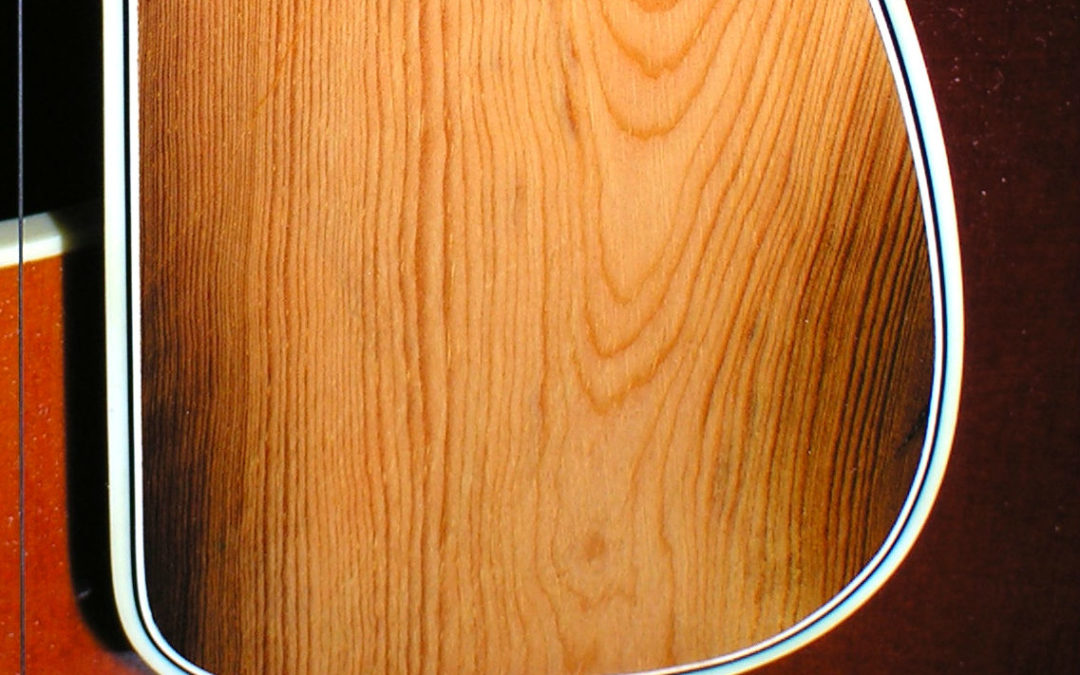
Pickguards, Player Story
By Bruce Graybill
When Bruce Weber built my first custom Weber Mandolin, he had me play for several of his builders using my ‘go to’ Mandolin of that time. He had some special cedar from a tree cut in 1910, that he thought would really work well for voicing the kinds of range and timbre of the classical pieces I was playing. Along with the incredible experience of having woods and building style specifically geared to the way I played Mandolin, Bruce helped me incorporate woods with poignant family history.
In 2004 I took a road trip through Montana, with my daughter, to celebrate her graduation from high school. While there we visited the homestead cabin site of my great grandfather, Andrew Pool, outside Greycliff, Montana. I had visited the cabin in 2001 while performing at at Classical Mandolin Society of American convention in Bozeman, Montana. At that time the homestead cabin was still mostly standing, the roof and upper walls caved in from decay. The homestead is now part of the 17,000 acre corporate ranch managed by Steve Story, who was very kind to provide me access to the site to photograph the cabin in 2001 and 2004, and visit the grave of my Great-Aunt Helen (daughter of Andrew and Myrtle Pool) that passed away as an infant at the homestead in 1917. On this second visit with my daughter, we were told in advance a forest fire had consumed the cabin in 2003. We were able to walk among the ashes of the cabin, and found two pieces of the original log walls that had not completely burned in the fire. One was the size of a cantaloupe, rather heavy and encased in burned charcoal. When I proudly laid the bag of charcoal pieces on Bruce Weber’s desk a few days later, black dust bellowed out really making a mess. He just laughed an told me it wasn’t a problem. He told me he would cut it open to see if there was any useable wood to incorporate in the custom build he was undertaking on my behalf. Fortunately, there was enough heat tempered wood to make it possible.
Featured are some pics of the homestead cabin when I visited the site in October 2001 and 2004 after it burned. At that time the cabin walls were still standing over about 80% of the structure. My Grandmother, Pansy Genevieve Pool rode the horse that pulled these logs up the mountain as her father cut the trees down for the cabin. She was around twelve years old at the time.
In addition to salvaging the wood for the pick guard and armrest on the first Mandolin, Bruce was able to get one larger piece to use as a pick guard on the Octave Mandolin he built for me. The scorched edges of the wood show through the clear finish. Having accessories made of this wood, the only remaining wood from my great grandfather’s homestead cabin, give a quality to this instrument that far exceeds it’s considerable intrinsic value. I am truly grateful to Bruce for his effort to make this possible.
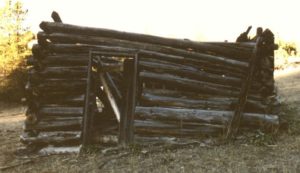
 Homestead After Fire
Homestead After Fire
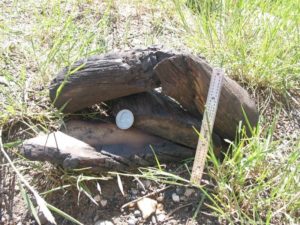 Piece used for Accessories
Piece used for Accessories

Award winning multi-instrumentalist, composer and singer-songwriter Bruce Graybill got his start in professional music as a lead Guitarist touring with ‘The Ebony Blue Show Band.’ In 1982 he was introduced to Mandolin and Winfield, later marrying into the family that brought him to both. Bruce has twice won first place in the Mandolin contest at the National Flat-pick Championships (Winfield). He is an endorsing artist for Weber fine acoustic Instruments and a former President of The Classical Mandolin Society of America Inc. Bruce currently performs solo, with the duo ‘Cordas Eclética’, the Gypsy Jazz ensemble ‘Hot Strings Trio’ and the Bluegrass / Americana band ‘The Wicked Stringbenders’, in the Kansas City area. Bruce also teaches privately and conducts workshops. Notable performances include The Grand Ole Opry, The Kennedy Center for the Performing Arts and Classical Mandolin Society of America conventions across North America. Two solo CDs: ‘Mandocranium an acoustic string Fantasy’ and ‘The Bell Effect’ roundout his discography of recordings by other artists. www.BruceGraybill.com ©2016 Mando Kinetics Music BMI
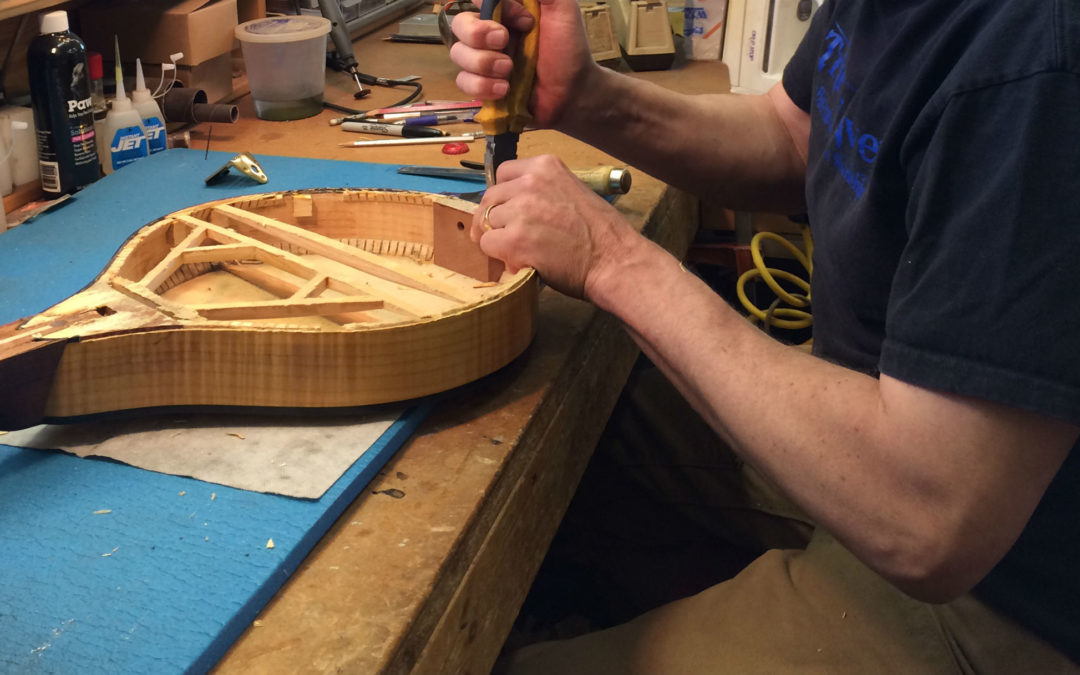
Mandolin Repair
“Peel away the hopeful interpretations, and the ‘vintage’ stands revealed as simply ‘old’…
The gap between my private logbook and the service ticket is the space where the ethics of
repairing motorcycles gets worked out.”
Shop Class as Soulcraft: An Inquiry Into the Value of Work
The topic of repair charges (though most may say the topic is ‘why does it cost so much?’) can provide an interesting discussion. I’ve been quoting from Shop Class as Soulcraft as we have really enjoyed this book on many levels, at this time in our lives. Bruce especially liked Chapter 5 which is entitled ‘The Further Education of a Gear Head’ because the author talks, among other things, about what goes into his billing for repair work.
First, anyone with a lawn mower or weedeater understands repair. You have to work on these small machines all of the time. Even if you take it in for repair at some point you ask yourself does this need, or deserve, fixing again? When is the cost too high? We had a mild mannered friend who made this decision by one day simply pouring gas on his lawn mower and torching it after bashing it with an ax a few times (he’s a banjo player in real life come to think of it : )
Mandolins aren’t lawn mowers, however, and one difference is if the cost is too high to make a vintage instrument playable again it will look beautiful hanging on your wall. Not because they were not fine instruments to begin with, but because so many of them need a lot of work to complete the owner’s request of, ‘just make it playable again’. This simple request begets new work as pieces and parts crumble while working on something else and then there’s a need to make a custom replacement part, on and on. Many of the neck joints in these older instruments are not pretty and take quite a bit of finagling too. These repairs are hard to estimate as one thing can lead to another. Even though the instrument may have significant personal value, most people can’t justify (or balk at) the cost. There are exceptions.

Bruce does like to fix old things, however: 1958 International, 1921 shop/school
Example: He recently worked on an early Flatiron F that the points had deteriorated on. While replacing the points, areas of binding started to crumble leading to a binding repair which led to finish touchup, and oh yeah, he just noticed a loose brace. The player would really like those stains in the finish on the peghead removed from years of a tuner being clamped to it? Strip and Tung oil that, reset the bushing and cleanup the tuners so you can turn them without a pliers. A re-fret led to replacing some of the fret markers and since we’ve gone that far might as well replace the nut and upgrade the bridge. Sand and buff, add a K&K, string it up, set it up to play like butter and it’s ready to rock again. It was a beautiful Instrument that was well worth the time put into it, but how do you charge for the actual time spent on all the little details that go into all those processes? Bruce usually doesn’t. Especially for players who are friendly and have a true concern for their babies (eight string that is). Building is a true art and repair, if it’s done correctly, takes it to a whole different level.
Bruce has been underbid almost weekly by back room repair shops. I asked if this irritated him and his response was no. Some of these will find their way here eventually to have the work redone correctly. He’s not saying there are not great repair luthiers out there, just that ‘least expensive’ is not always the best choice. Remember, it’s not a lawn mower.
Of course, if a newer instrument has been severely mistreated or damaged the cost may outweigh the benefit also, but when you think it through, you see the market (thus pricing) is legitimate if a finely made, newer instrument still costs more than the repair cost to fix most problems and also helps to maintain the value of the investment- more like a car than a lawn mower.
Simple repairs may be performed on, how-to-say-it-nicely, cheapy mandolins but a good repair person may refuse to do major repairs (put a new top on it or ‘make it sound better’) even if the customer is willing to pay. It won’t work even if the customer goes away happy.
This leads to the issue of the responsibility to the mandolin itself. Bruce gets many instruments where the request is to tune it up, check things out, and spruce it up a bit. Sounds straight forward but like doing a painting, when do you know it’s done or time to stop? It’s similar for more straight forward work such as a fret job. Even though he’s had many years of experience in creating and building, thus judging this invisible point, it’s hard to stop sometimes. There is simply usually something that will improve the mandolin even though it wasn’t requested, it just needs to be done, mixed in with a little obsessiveness. Then there is the wild request that turns out taking forever to find/get the material, then make whatever, then figure out how to actually put it on/in the instrument and you can’t charge for 20 hours, besides it was fun! All this to say there is a lot of time put into repair usually that isn’t charged out, but needs to be done.
Hopefully this explains an estimate you might get and improves communication so that you, the player, are happy with the outcome. Give Bruce a call or email if you would like to talk over a repair or customization.






 Homestead After Fire
Homestead After Fire Piece used for Accessories
Piece used for Accessories


